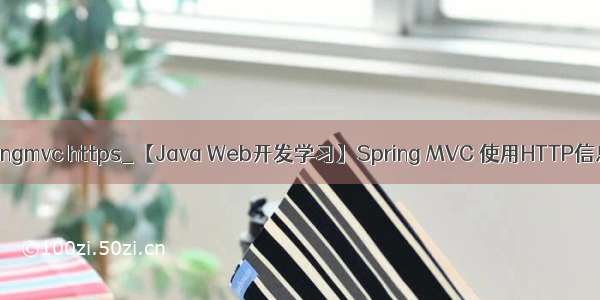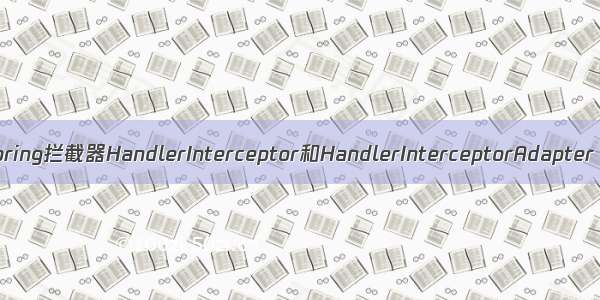
【Java Web开发学习】Spring MVC 拦截器HandlerInterceptor
转载:/yangchongxing/p/9324119.html
目录
1、拦截器接口代码
2、拦截器方法调用顺序
3、自定义拦截器实现
4、拦截器配置
正文
1、拦截器接口代码
/** Copyright 2002- the original author or authors.** Licensed under the Apache License, Version 2.0 (the "License");* you may not use this file except in compliance with the License.* You may obtain a copy of the License at**/licenses/LICENSE-2.0** Unless required by applicable law or agreed to in writing, software* distributed under the License is distributed on an "AS IS" BASIS,* WITHOUT WARRANTIES OR CONDITIONS OF ANY KIND, either express or implied.* See the License for the specific language governing permissions and* limitations under the License.*/package org.springframework.web.servlet;import javax.servlet.http.HttpServletRequest;import javax.servlet.http.HttpServletResponse;import org.springframework.web.method.HandlerMethod;/*** Workflow interface that allows for customized handler execution chains.* Applications can register any number of existing or custom interceptors* for certain groups of handlers, to add common preprocessing behavior* without needing to modify each handler implementation.** <p>A HandlerInterceptor gets called before the appropriate HandlerAdapter* triggers the execution of the handler itself. This mechanism can be used* for a large field of preprocessing aspects, e.g. for authorization checks,* or common handler behavior like locale or theme changes. Its main purpose* is to allow for factoring out repetitive handler code.** <p>In an asynchronous processing scenario, the handler may be executed in a* separate thread while the main thread exits without rendering or invoking the* {@code postHandle} and {@code afterCompletion} callbacks. When concurrent* handler execution completes, the request is dispatched back in order to* proceed with rendering the model and all methods of this contract are invoked* again. For further options and details see* {@code org.springframework.web.servlet.AsyncHandlerInterceptor}** <p>Typically an interceptor chain is defined per HandlerMapping bean,* sharing its granularity. To be able to apply a certain interceptor chain* to a group of handlers, one needs to map the desired handlers via one* HandlerMapping bean. The interceptors themselves are defined as beans* in the application context, referenced by the mapping bean definition* via its "interceptors" property (in XML: a <list> of <ref>).** <p>HandlerInterceptor is basically similar to a Servlet Filter, but in* contrast to the latter it just allows custom pre-processing with the option* of prohibiting the execution of the handler itself, and custom post-processing.* Filters are more powerful, for example they allow for exchanging the request* and response objects that are handed down the chain. Note that a filter* gets configured in web.xml, a HandlerInterceptor in the application context.** <p>As a basic guideline, fine-grained handler-related preprocessing tasks are* candidates for HandlerInterceptor implementations, especially factored-out* common handler code and authorization checks. On the other hand, a Filter* is well-suited for request content and view content handling, like multipart* forms and GZIP compression. This typically shows when one needs to map the* filter to certain content types (e.g. images), or to all requests.** @author Juergen Hoeller* @since 20.06.* @see HandlerExecutionChain#getInterceptors* @see org.springframework.web.servlet.handler.HandlerInterceptorAdapter* @see org.springframework.web.servlet.handler.AbstractHandlerMapping#setInterceptors* @see org.springframework.web.servlet.handler.UserRoleAuthorizationInterceptor* @see org.springframework.web.servlet.i18n.LocaleChangeInterceptor* @see org.springframework.web.servlet.theme.ThemeChangeInterceptor* @see javax.servlet.Filter*/public interface HandlerInterceptor {/*** Intercept the execution of a handler. Called after HandlerMapping determined* an appropriate handler object, but before HandlerAdapter invokes the handler.* <p>DispatcherServlet processes a handler in an execution chain, consisting* of any number of interceptors, with the handler itself at the end.* With this method, each interceptor can decide to abort the execution chain,* typically sending a HTTP error or writing a custom response.* <p><strong>Note:</strong> special considerations apply for asynchronous* request processing. For more details see* {@link org.springframework.web.servlet.AsyncHandlerInterceptor}.* @param request current HTTP request* @param response current HTTP response* @param handler chosen handler to execute, for type and/or instance evaluation* @return {@code true} if the execution chain should proceed with the* next interceptor or the handler itself. Else, DispatcherServlet assumes* that this interceptor has already dealt with the response itself.* @throws Exception in case of errors*/boolean preHandle(HttpServletRequest request, HttpServletResponse response, Object handler)throws Exception;/*** Intercept the execution of a handler. Called after HandlerAdapter actually* invoked the handler, but before the DispatcherServlet renders the view.* Can expose additional model objects to the view via the given ModelAndView.* <p>DispatcherServlet processes a handler in an execution chain, consisting* of any number of interceptors, with the handler itself at the end.* With this method, each interceptor can post-process an execution,* getting applied in inverse order of the execution chain.* <p><strong>Note:</strong> special considerations apply for asynchronous* request processing. For more details see* {@link org.springframework.web.servlet.AsyncHandlerInterceptor}.* @param request current HTTP request* @param response current HTTP response* @param handler handler (or {@link HandlerMethod}) that started asynchronous* execution, for type and/or instance examination* @param modelAndView the {@code ModelAndView} that the handler returned* (can also be {@code null})* @throws Exception in case of errors*/void postHandle(HttpServletRequest request, HttpServletResponse response, Object handler, ModelAndView modelAndView)throws Exception;/*** Callback after completion of request processing, that is, after rendering* the view. Will be called on any outcome of handler execution, thus allows* for proper resource cleanup.* <p>Note: Will only be called if this interceptor's {@code preHandle}* method has successfully completed and returned {@code true}!* <p>As with the {@code postHandle} method, the method will be invoked on each* interceptor in the chain in reverse order, so the first interceptor will be* the last to be invoked.* <p><strong>Note:</strong> special considerations apply for asynchronous* request processing. For more details see* {@link org.springframework.web.servlet.AsyncHandlerInterceptor}.* @param request current HTTP request* @param response current HTTP response* @param handler handler (or {@link HandlerMethod}) that started asynchronous* execution, for type and/or instance examination* @param ex exception thrown on handler execution, if any* @throws Exception in case of errors*/void afterCompletion(HttpServletRequest request, HttpServletResponse response, Object handler, Exception ex)throws Exception;}
2、拦截器方法调用顺序
preHandle:在Controller方法调用之前执行,主要进行初始化操作。返回值:true表示继续流程,false表示流程中断。
postHandle:在Controller方法调用之后渲染视图之前执行。
afterCompletion:整个请求处理完毕,视图渲染完成后执行。
3、自定义拦截器实现
Spring提供了适配器HandlerInterceptorAdapter,我们只要实现适配器中需要的方法即可
public class AuthenticationInterceptor extends HandlerInterceptorAdapter {@Overridepublic boolean preHandle(HttpServletRequest request, HttpServletResponse response, Object object) throws Exception {System.out.println(">>> preHandle");return true;}@Overridepublic void postHandle(HttpServletRequest request, HttpServletResponse response, Object handler, ModelAndView modelAndView) throws Exception {System.out.println(">>> postHandle");}@Overridepublic void afterCompletion(HttpServletRequest request, HttpServletResponse response, Object handler, Exception ex) throws Exception {System.out.println(">>> afterCompletion");}}
4、拦截器配置
基于ant的通配符拦截所有/**。
基于code-base
@Configuration@EnableWebMvc //启用spirng mvc java配置,相当于<mvc:annotation-driven/>@ComponentScan(basePackages = {"cn.ycx.web.controller"},// 仅仅扫描includeFilters = {@Filter( type=FilterType.ANNOTATION, value={org.springframework.stereotype.Controller.class} )})public class ServletConfig extends WebMvcConfigurerAdapter {/*** 自定义拦截器* @return*/@Beanpublic AuthenticationInterceptor handlerInterceptor() {return new AuthenticationInterceptor();}/*** 添加拦截器*/@Overridepublic void addInterceptors(InterceptorRegistry registry) {registry.addInterceptor(handlerInterceptor()).addPathPatterns("/**").excludePathPatterns(new String[] {"/","/login","/resource/**"});}}
基于xml-base
<mvc:interceptors><mvc:interceptor><mvc:mapping path="/**"/><bean class="cn.ycx.web.interceptor.AuthenticationInterceptor" ></bean></mvc:interceptor></mvc:interceptors>
















